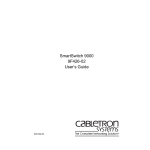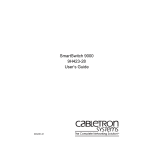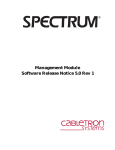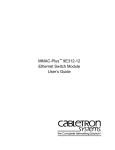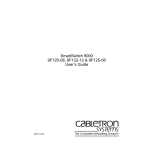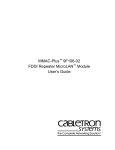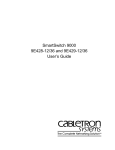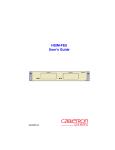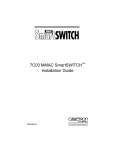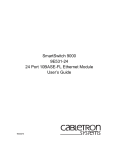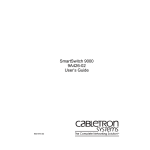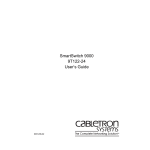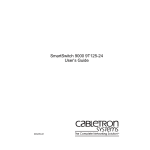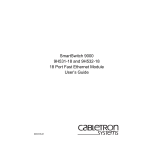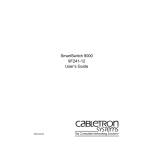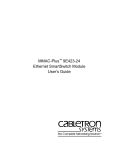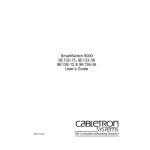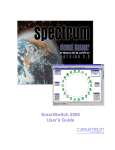Download Enterasys SmartSwitch 9000 Expansion Module
Transcript
SmartSwitch 9000 9H421-12, 9H422-12 and 9H429-12 User’s Guide 9031928-03 Notice Notice Cabletron Systems reserves the right to make changes in specifications and other information contained in this document without prior notice. The reader should in all cases consult Cabletron Systems to determine whether any such changes have been made. The hardware, firmware, or software described in this manual is subject to change without notice. IN NO EVENT SHALL CABLETRON SYSTEMS BE LIABLE FOR ANY INCIDENTAL, INDIRECT, SPECIAL, OR CONSEQUENTIAL DAMAGES WHATSOEVER (INCLUDING BUT NOT LIMITED TO LOST PROFITS) ARISING OUT OF OR RELATED TO THIS MANUAL OR THE INFORMATION CONTAINED IN IT, EVEN IF CABLETRON SYSTEMS HAS BEEN ADVISED OF, KNOWN, OR SHOULD HAVE KNOWN, THE POSSIBILITY OF SUCH DAMAGES. © Copyright March 1998 by: Cabletron Systems, Inc. 35 Industrial Way Rochester, NH 03867-5005 All Rights Reserved Printed in the United States of America Order Number: 9031928-03 LANVIEW is a registered trademark, and SmartSwitch is a trademark of Cabletron Systems, Inc. CompuServe is a registered trademark of CompuServe, Inc. i960 microprocessor is a registered trademark of Intel Corp. Ethernet is a trademark of Xerox Corporation. i Notice FCC Notice This device complies with Part 15 of the FCC rules. Operation is subject to the following two conditions: (1) this device may not cause harmful interference, and (2) this device must accept any interference received, including interference that may cause undesired operation. NOTE: This equipment has been tested and found to comply with the limits for a Class A digital device, pursuant to Part 15 of the FCC rules. These limits are designed to provide reasonable protection against harmful interference when the equipment is operated in a commercial environment. This equipment uses, generates, and can radiate radio frequency energy and if not installed in accordance with the operator’s manual, may cause harmful interference to radio communications. Operation of this equipment in a residential area is likely to cause interference in which case the user will be required to correct the interference at his own expense. WARNING: Changes or modifications made to this device which are not expressly approved by the party responsible for compliance could void the user’s authority to operate the equipment. VCCI Notice This is a Class A product based on the standard of the Voluntary Control Council for Interference by Information Technology Equipment (VCCI). If this equipment is used in a domestic environment, radio disturbance may arise. When such trouble occurs, the user may be required to take corrective actions. DOC Notice This digital apparatus does not exceed the Class A limits for radio noise emissions from digital apparatus set out in the Radio Interference Regulations of the Canadian Department of Communications. Le présent appareil numérique n’émet pas de bruits radioélectriques dépassant les limites applicables aux appareils numériques de la class A prescrites dans le Règlement sur le brouillage radioélectrique édicté par le ministère des Communications du Canada. ii Notice DECLARATION OF CONFORMITY ADDENDUM Application of Council Directive(s): Manufacturer’s Name: Manufacturer’s Address: European Representative Name: European Representative Address: Conformance to Directive(s)/Product Standards: Equipment Type/Environment: 89/336/EEC 73/23/EEC Cabletron Systems, Inc. 35 Industrial Way PO Box 5005 Rochester, NH 03867 Mr. J. Solari Cabletron Systems Limited Nexus House, Newbury Business Park London Road, Newbury Berkshire RG13 2PZ, England EC Directive 89/336/EEC EC Directive 73/23/EEC EN 55022 EN 50082-1 EN 60950 Networking Equipment, for use in a Commercial or Light Industrial Environment. We the undersigned, hereby declare, under our sole responsibility, that the equipment packaged with this notice conforms to the above directives. Manufacturer Legal Representative in Europe Mr. Ronald Fotino ____________________________________________________ Full Name Mr. J. Solari ______________________________________________________ Principal Compliance Engineer ____________________________________________________ Title Managing Director - E.M.E.A. ______________________________________________________ Rochester, NH, USA ____________________________________________________ Location Newbury, Berkshire, England ______________________________________________________ Location Full Name Title iii Notice Safety Information CLASS 1 LASER TRANSCEIVERS The 9H421-12, 9H429-12 and FE-100FX are Class 1 Laser Product CLASS 1 LASER PRODUCT The 9H421-12, 9H429-12 and FE-100FX use a Class 1 Laser transceiver. Read the following safety information before installing or operating these adapters. The Class 1 laser transceivers use an optical feedback loop to maintain Class 1 operation limits. This control loop eliminates the need for maintenance checks or adjustments. The output is factory set, and does not allow any user adjustment. Class 1 Laser transceivers comply with the following safety standards: • 21 CFR 1040.10 and 1040.11 U.S. Department of Health and Human Services (FDA). • IEC Publication 825 (International Electrotechnical Commission). • CENELEC EN 60825 (European Committee for Electrotechnical Standardization). When operating within their performance limitations, laser transceiver output meets the Class 1 accessible emission limit of all three standards. Class 1 levels of laser radiation are not considered hazardous. iv Notice Safety Information CLASS 1 LASER TRANSCEIVERS Laser Radiation and Connectors When the connector is in place, all laser radiation remains within the fiber. The maximum amount of radiant power exiting the fiber (under normal conditions) is -12.6 dBm or 55 x 10-6 watts. Removing the optical connector from the transceiver allows laser radiation to emit directly from the optical port. The maximum radiance from the optical port (under worst case conditions) is 0.8 W cm-2 or 8 x 103 W m2 sr-1. Do not use optical instruments to view the laser output. The use of optical instruments to view laser output increases eye hazard. When viewing the output optical port, power must be removed from the network adapter. v Notice vi Contents Chapter 1 Introduction Features........................................................................................................................... 1-1 Related Manuals............................................................................................................ 1-5 Getting Help .................................................................................................................. 1-5 Chapter 2 Installing the SmartSwitch 9000 Module Unpacking the Module................................................................................................. 2-1 Installing an FEPIM ...................................................................................................... 2-1 User Accessible Components ...................................................................................... 2-2 Installing the Module into the SmartSwitch 9000 Chassis...................................... 2-6 The Reset Switch ........................................................................................................... 2-8 Chapter 3 Operation FENIB.............................................................................................................................. 3-3 SmartSwitch ASIC......................................................................................................... 3-3 Traditional Switch.................................................................................................. 3-3 SecureFast Switch (SFS) ........................................................................................ 3-3 i960 Core......................................................................................................................... 3-4 INB NIB .......................................................................................................................... 3-4 System Management Buses ......................................................................................... 3-4 SMB-1 Bus ............................................................................................................... 3-4 SMB-10 Bus ............................................................................................................. 3-5 System Diagnostic Controller...................................................................................... 3-5 DC/DC Converter ........................................................................................................ 3-5 INB Interface.................................................................................................................. 3-6 Chapter 4 LANVIEW LEDs Chapter 5 Specifications Technical Specifications......................................................................................... 5-1 CPU................................................................................................................... 5-1 Memory............................................................................................................ 5-1 Standards ......................................................................................................... 5-1 Network Interface........................................................................................... 5-1 Safety ....................................................................................................................... 5-1 Service...................................................................................................................... 5-2 vii Contents Physical.................................................................................................................... 5-2 Dimensions ...................................................................................................... 5-2 Weight............................................................................................................... 5-2 Environment .................................................................................................... 5-2 Appendix A FEPIM Specifications FE-100TX........................................................................................................................A-1 FE-100FX........................................................................................................................A-2 viii Chapter 1 Introduction The 9H421-12, 9H422-12 and the 9H429-12, shown in Figure 1-1, are Fast Ethernet SmartSwitch® Modules for the SmartSwitch 9000. The 9H422-12 is a twelve port switch module, with eleven 10BASE-T/100BASETX ports and one FEPIM (Fast Ethernet Port Interface Module), on the front panel. The FEPIM port accepts either the FE-100TX, for use with twisted pair copper, or the FE-100FX, for use with mulitmode fiber optic cabling. The 9H421-12 is a twelve port switch module, equipped with twelve 100BASE-FX multimode fiber (MMF) ports. The 9H429-12 is a twelve port switch module, equipped with twelve 100BASE-FX single mode fiber (SMF) ports. These modules connect to the SmartSwitch 9000 INB-2 backplane interface, and employ the family of SmartSwitch ASICs, a high performance switch design, and an Intel i960 microprocessor. Features Processor The 9H421-12, 9H422-12, and the 9H429-12 are equipped with an advanced Intel i960 microprocessor. This microprocessor provides a platform for all management functions. Packet Switch Engine These modules incorporate the family of SmartSwitch ASICs, a collection of custom ASICs designed specifically for high speed switching. The SmartSwitch ASIC bus is 64 bits wide with a bandwidth of 845 Mbps. Since all frame translation, address lookups, and forwarding decisions are performed in hardware, these modules can obtain a throughput performance of greater than 990K pps. 1-1 Introduction Management The 9H421-12, 9H422-12 and the 9H429-12 modules support SNMP for local and remote management. Local management is provided through the RS-232 Com ports on the SmartSwitch 9000 Environmental Module using a standard VT-220 terminal or emulator. Remote management is possible through Cabletron’s SPECTRUM or any SNMP compliant management tool as well as telneting to the module. Management features include module configuration and statistics. All Fast Ethernet interfaces provide frames filtered, frames forwarded, and all Spanning Tree Protocol parameters. All modules support RMON (RFC-1757), IETF MIB II (RFC-1213), IETF BRIDGE MIB (RFC-1493), and a host of Cabletron enterprise MIBs. In addition, the front panel provides LEDs for link status per port as well as transmit and receive activity. Connectivity The 9H421-12, 9H422-12 and the 9H429-12 modules have one interface to the INB2 and twelve front panel Fast Ethernet interfaces. The front panel connections for the 9H422-12 are via eleven standard RJ45 connectors and one FEPIM. Front panel connections for the 9H421-12 are via twelve standard multimode fiber SC connectors, providing links up to 2000 meters in length, when operating in half duplex (point to point) or full duplex. Distance of links on a shared LAN in half duplex is 412 meters. The 9H429-12 single mode SC connectors provide twelve Fast Ethernet 100BASEFX connections, with links up to 10000 to 15000 meters in length, when operating in half duplex (point to point) or full duplex. Distance of links on a shared LAN in half duplex is 412 meters. Auto-negotiation The auto-negotiation feature (available only with the 9H422-12 module) allows the module to automatically use the fastest rate supported by the device at the other end (either 10 Mbps or 100 Mbps at either half or full duplex). To negotiate duplex, both the 9H422-12 and the attached device must be configured for autonegotiation. If only the 9H422-12 is configured for auto-negotiation, the module will set the connection to half duplex at either the 10 Mbps or 100 Mbps rate. This technology is similar to how modems negotiate transmission speed, finding the highest transmission rate possible. Similarly, auto-negotiation determines the highest common speed between two devices and communicates at that speed. If no common speed is detected, the device will be partitioned. NOTE 1-2 All RJ45 connections are capable of auto-negotiation, and can operate at 10 Mbps or 100 Mbps, full or half duplex. Fiber connections can only operate at the 100 Mbps rate, full or half duplex. Introduction Management Information Base (MIB) Support The 9H421-12, 9H422-12 and the 9H429-12 modules provide MIB support including: • • • • • NOTE Cabletron Fast Ethernet MIB IETF MIB II IETF Bridge MIB RMON a host of Cabletron Enterprise MIBs For a complete list of supported MIBs, refer to the release notes provided in the 9H421-12, 9H422-12 and the 9H429-12 module packages. LANVIEW LEDs The 9H421-12, 9H422-12 and the 9H429-12 modules use LANVIEW – the Cabletron Systems built-in visual diagnostic and status monitoring system. With LANVIEW LEDs, you can quickly identify the device, port, and physical layer status at a glance. 1-3 Introduction FAST ENET FAST ENET FAST ENET 9H421-12 9H429-12 9H422-12 SMB INB CPU SMB CPU INB Figure 1-1. The 9H421-12, 9H429-12 and 9H422-12 Modules 1-4 SMB INB CPU Introduction Related Manuals The manuals listed below should be used to supplement the procedures and technical data contained in this manual. SmartSwitch 9000 Installation Guide SmartSwitch 9000 9C300-1 Environmental Module User’s Guide SmartSwitch 9000 9C214-1 AC Power Supply User’s Guide INB Terminator Modules Installation Guide SmartSwitch 9000 Module Local Management User’s Guide Getting Help For additional support related to this device or document, contact the Cabletron Systems Global Call Center: Phone (603) 332-9400 Internet mail [email protected] FTP Login Password ctron.com (134.141.197.25) anonymous your email address Modem setting (603) 335-3358 8N1: 8 data bits, No parity, 1 stop bit BBS For additional information about Cabletron Systems or its products, visit the World Wide Web site: http://www.cabletron.com/ For technical support, select Service and Support. To send comments or suggestions concerning this document, contact the Cabletron Systems Technical Writing Department via the following email address: [email protected] Make sure to include the document Part Number in the email message. Before calling the Cabletron Systems Global Call Center, have the following information ready: • Your Cabletron Systems service contract number • A description of the failure • A description of any action(s) already taken to resolve the problem (e.g., changing mode switches, rebooting the unit, etc.) • The serial and revision numbers of all involved Cabletron Systems products in the network • A description of your network environment (layout, cable type, etc.) • Network load and frame size at the time of trouble (if known) • The device history (i.e., have you returned the device before, is this a recurring problem, etc.) • Any previous Return Material Authorization (RMA) numbers 1-5 Introduction 1-6 Chapter 2 Installing the SmartSwitch 9000 Module The 9H421-12, 9H422-12 and the 9H429-12 modules each occupy a single slot in the SmartSwitch 9000 chassis. Install any of these modules by following the steps starting below. Unpacking the Module 1. Carefully remove the module from the shipping box. (Save the box and packing materials in the event the module must be reshipped.) 2. Remove the module from the static bag. Observe all precautions to prevent damage from Electrostatic Discharge (ESD). 3. Carefully examine the module, checking for damage. If any damage exists, DO NOT install the module. Contact Cabletron Systems Technical Support immediately. Installing an FEPIM The 9H422-12 provides a slot for a Cabletron FEPIM (Fast Ethernet Port Interface Module). The 9H422-12 SmartSwitch module is shipped without an FEPIM. To install an FEPIM, follow the procedure below: 1. Remove the module if it is installed in the SmartSwitch 9000 chassis. 2. Remove the two screws securing the plate on the side of the FEPIM slot. 3. Install the FEPIM as shown in Figure 2-1. Ensure that the rear connector is seated firmly before tightening the three mounting screws. 4. Replace the plate and two screws on the side of the FEPIM slot. 2-1 Installing the SmartSwitch 9000 Module Figure 2-1. Installing an FEPIM User Accessible Components Figure 2-2 shows the various components that are accessible to the user. These consist of an eight position DIP switch (explained below), replaceable PROMs and sockets for RAM. These will be used for future upgrades. Instructions for installing the components will be supplied with the upgrade kit. 2-2 Installing the SmartSwitch 9000 Module SMB 10 St FEPIM Connector Flash CNXSTATS Connector Boot Prom DRAM Dip Switches Figure 2-2. 9H422-12 User Accessible Components 2-3 Installing the SmartSwitch 9000 Module SMB 10 Prom Flash CNXSTATS Connector Boot Prom DRAM Dip Switches Figure 2-3. 9H421-12 and 9H429-12 User Accessible Components An eight position DIP switch is located on the module card as shown in Figure 2-2 and Figure 2-3. The function of the switches are listed in Table 2-1. 2-4 Installing the SmartSwitch 9000 Module See the Cautions at the end of this table. Table 2-1. Function of DIP Switch Switch Function Description 8 Clear Password 1 When toggled, this switch clears user-entered passwords stored in NVRAM, and restores the default passwords (public). Once reset you can use the defaults or enter new passwords. Clear NVRAM 2 The module uses NVRAM to store user entered parameters such as IP addresses, community names, etc. To reset these parameters to the factory defaults, toggle this switch. Once reset you can use the defaults or enter new parameters which are stored in NVRAM when the module is powered down, and remain there until the switch is toggled again. 6 Force BootP Download Toggling this switch after pulling the board out of the SmartSwitch 9000, clears download information from NVRAM and forces image files to be downloaded upon power-up from the station connected to the EPIM on the Environmental Module configured to act as that modules’ BOOTP server. 5 Reserved For Factory Use Only 4 Reserved For Factory Use Only 3 Reserved For Factory Use Only 2 Reserved For Factory Use Only 1 Reserved For Factory Use Only 7 ! CAUTION Caution: Do not toggle Switch 8 unless you intend to reset the user configured passwords to their factory default settings. Caution: Do not toggle Switch 7 unless you intend to reset the user parameters to the factory default settings. 2-5 Installing the SmartSwitch 9000 Module Installing the Module into the SmartSwitch 9000 Chassis To install the SmartSwitch 9000 module, follow the steps below: NOTE The INB Terminator Modules must be installed on the rear of the chassis before powering up this module. Refer to the INB Terminator Modules Installation Guide for information and installation procedure. 1. Remove the blank panels, covering the slots that the module is being mounted in. All other slots must be covered, if modules are not being installed, to ensure proper airflow and cooling. 2. Attach one end of the ESD wrist strap packaged with the SmartSwitch 9000 chassis to your wrist. Plug the other end into the ESD Wrist Strap Grounding receptacle in the lower right corner of the SmartSwitch 9000 chassis shown in Figure 2-4. 3. The module is installed into the chassis by sliding it into slots and locking down both the top and bottom plastic tabs, as shown in Figure 2-4. Take care that the module slides in straight and engages the backplane connectors properly. When installing the module, ensure that both circuit cards are between the card guides, as shown in Figure 2-4. Check both the upper and lower tracks of both cards. 2-6 Installing the SmartSwitch 9000 Module Plastic Tab Jack for ESD Wrist Strap Metal Back-Panel Module Module Guides Warning: Ensure that the circuit card is between the card guides. Lock down the top and bottom plastic tabs at the same time, applying even pressure. Figure 2-4. Installing the 9H421-12, 9H422-12 and 9H429-12 Modules 2-7 Installing the SmartSwitch 9000 Module The Reset Switch The Reset switch is located under the top plastic tab as shown in Figure 2-5. It serves two functions: • • Pressing the reset switch twice within three seconds causes the processor (i960) to reset. Pressing and holding the switch on for three or more seconds causes the module to shutdown. Momentarily pressing the switch restarts the module. SNMP management may be used to disable this switch to enhance module security. Reset Switch SMB CPU Figure 2-5. The Reset Switch 2-8 Chapter 3 Operation The 9H422-12 is a twelve port switch module, with eleven 10BASE-T/100BASETX ports and one FEPIM (Fast Ethernet Port Interface Module), on the front panel. The FEPIM port accepts either the FE-100TX, for use with twisted pair copper, or the FE-100FX, for use with mulitmode fiber optic cabling. The 9H421-12 is a twelve port switch module, equipped with twelve multimode fiber 100BASE-FX ports. The 9H429-12 is a twelve port switch module, equipped with twelve single mode fiber 100BASE-FX ports. The 9H422-12 is 10BASE-T and 100BASE-TX compatible and provides autonegotiation for automatic speed selection. The 9H421-12 and 9H429-12 are 100BASE-FX compatible and operate only at 100 Mbps. Each module can operate in either full duplex or half duplex mode. Autonegotiation for 100BASE-T modules provides support for 10 Mbps and 100 Mbps speeds at both half and full duplex. 100BASE-FX supports 100 Mbps speed at both half and full duplex. As shown in Figure 3-1, Fast Ethernet Network Interface Blocks (FENIBs) convert data packets received from any of the front panel ports into a canonical frame format before forwarding to the SmartSwitch ASIC, while the Internal Network Bus Network Interface Block (INB NIB) converts data packets received from the INB into a canonical format before forwarding to the SmartSwitch ASIC. The FENIBs are each designed to handle traffic from two front panel ports. 3-1 Operation FENIB SMB 1 FENIB i960 Processor Diagnostic Controller SMB 10 DC/DC Convertor FENIB 1 FENIB Smart Switch ASIC INB NIB I N B 2 FENIB FENIB Figure 3-1. Packet Flow All data packets destined for a front panel port, the INB, or the i960 are converted into the canonical format before forwarding to the SmartSwitch ASIC. Network Interface Blocks (NIBS) check for valid data packets entering the system. If an errored data packet is found, the SmartSwitch ASIC flags the error and does not forward the errored data packet to any outbound ports. Once in this common format, the SmartSwitch ASIC decides from header information the port destination of data packets. Data packets are then converted from the canonical format to the proper format for the interface destination whether it is a front panel port, or connection to the INB. 3-2 Operation FENIB The Fast Ethernet Network Interface Block (FENIB) converts Ethernet data packets received through front panel ports into a common canonical format that allows the SmartSwitch ASIC Engine to determine the proper destination port. The FENIB also converts data packets from the common canonical format back to Ethernet data packets for transmission out front panel ports. SmartSwitch ASIC The SmartSwitch ASIC is a hardware based switch design that is the key building block of the SmartSwitch 9000 hub. The SmartSwitch ASIC makes all filtering/ forwarding decisions in custom hardware as opposed to software like traditional bridges. This custom hardware enables the SmartSwitch ASIC to process over 990K frames per second. The SmartSwitch ASIC is designed to support up to 64 ports shared between the host processor, the INB backplane, and LAN/WAN interfaces on the front panel of SmartSwitch 9000 modules. The SmartSwitch ASIC can operate in two modes; as a traditional switch or as a SecureFast Switch (SFS). Traditional Switch When operating as a traditional switch, the SmartSwitch ASIC makes filtering/ forwarding decisions based on Destination Address (DA), with standard IEEE 802.1d learning. SecureFast Switch (SFS) When operating as an SFS switch, the SmartSwitch ASIC makes all filtering/forwarding decisions based on a Destination Address-Source Address (DA-SA) pair and its receive port. These DA-SA pairs with the associated receive port are programmed into the switch using Cabletron’s SecureFast Virtual Network Server (SecureFast VLAN). This provides the network administrator with the ultimate network security without the performance degradation found when using routers or bridges with special filtering capabilities. The SmartSwitch 9000 hub can support individual modules operating in the traditional switch mode or SFS mode providing security where needed. 3-3 Operation i960 Core The i960 core provides the SNMP protocol stacks, to support industry standard MIBs. Additionally, Cabletron enterprise extension MIBs are supported for each media type. Advanced management services, such as telnet and network address to MAC address mapping, are also provided by the i960 core. The Host engine sends and receives packets via the CPU’s SmartSwitch ASIC Interface. This allows the bridge to perform spanning tree protocol and other bridging functions. The SMB Interfaces provide communication to the Host Engine for management functions. INB NIB Each module that attaches to the Internal Network Bus (INB) has an INB Network Interface Block (NIB). The INB NIB converts canonical frames to fixed length data blocks for transmission onto the INB. For data blocks received from the INB, the INB NIB reassembles the data blocks received from the INB back into canonical frames for transmission to the SmartSwitch ASIC then from the SmartSwitch ASIC to the front panel ports. System Management Buses There are two management channels within the SmartSwitch 9000 system: the SMB-1 and the SMB-10. These buses provide side-band management and intermodule management communication. SMB-1 Bus The SMB-1 is a 1 Mbps management bus located within the SmartSwitch 9000. This bus is utilized by all diagnostic controllers in the system including connectivity modules, power supply modules and the environmental module. The SMB-1 transports inter-chassis information between system components, such as power and environmental information, as well as diagnostic messages. Periodic loop-back tests are performed by all modules which share this bus to ensure the validity of SMB-1. In the event a failure is detected on SMB-1, the SMB10 may be used as an alternate communication channel. 3-4 Operation SMB-10 Bus The SMB-10 is a 10 Mbps management bus located within the SmartSwitch 9000. This bus is used for inter-chassis communication of modules as well as serving as a side-band management channel into the SmartSwitch 9000. The SMB-10 is externalized from the chassis via an optional Ethernet Port Interface Module (EPIM) located on the front of the Environmental Module. Through an EPIM connection, full SNMP management of the SmartSwitch 9000 is available side-band from user data. Modules which share the SMB-10 bus periodically send out loop-back packets to ensure the validity of SMB-10. If a fault is detected on the SMB-10, the SMB-1 can be used as an alternate communication channel by the modules. System Diagnostic Controller This diagnostic controller is composed of a Z-80 microprocessor and its supporting logic. The diagnostic controller is designed to control the power-up sequencing of modules, monitor the 9H421-12, 9H422-12 and the 9H429-12 input and output power parameters, keep watch over the main host processor, monitor the temperature, and control the SMB LANVIEW diagnostic LEDs. Although the system diagnostic controller and the main host processor can operate independently of each other if needed, they exchange information about each others status and overall module condition. The information gathered by the diagnostic controller is available to the network manager via local/remote management and the LCD located on the environment module. The 9H421-12, 9H422-12 and the 9H429-12 are designed to continue functioning in the event of a diagnostic controller fault. DC/DC Converter The DC/DC converter converts the 48 VDC on the system power bus to the necessary operating voltages for its host network services module. The diagnostic controller monitors and controls the operation of the DC/DC converter. 3-5 Operation INB Interface The INB Backplane is designed to transport fixed length data blocks between modules in the SmartSwitch 9000 using a Time Division Multiplexing (TDM) design. The SmartSwitch 9000 INB bus delivers 2.0 Gbps of true data bandwidth with all control and management communication being serviced on the 8 bit outof-band bus. The INB can time slice its bandwidth using one of three methods. The default method is standard TDM round-robin bandwidth arbitration, the second method is for modules to reserve a specific amount of bandwidth using INB Manager, Cabletron’s INB Bandwidth Arbitrator, the third method permits the lowest slot number to use any bandwidth not used by the previous two methods. 3-6 Chapter 4 LANVIEW LEDs The front panel LANVIEW LEDs indicate the status of the module and may be used as an aid in troubleshooting. Figure 4-1 and Figure 4-2 show the LANVIEW LEDs of the 9H421-12, 9H422-12 and the 9H429-12 modules. FAST ENET 9H422-12 INB Receive SMB INB System Status CPU INB Transmit Port Receive Port Transmit Figure 4-1. 9H422-12 LANVIEW LEDs 4-1 LANVIEW LEDs FAST ENET System Status INB Receive SMB INB CPU INB Transmit Port Receive Port Transmit Figure 4-2. 9H421-12 and 9H429-12 LANVIEW LEDS 4-2 LANVIEW LEDs The function of the two System Status LEDs, System Management Bus (SMB) and CPU (Central Processing Unit), are listed in Table 4-1. Table 4-1. System Status (SMB and CPU) LEDs LED Color State Description Green Functional Fully operational Yellow Testing Power up testing Yellow (Blinking) Crippled Not fully operational (i.e. one port may be bad) Yellow/Green Booting Module is performing its boot process Red Reset Module is resetting Red (Blinking) Failed Fatal error Off Power off Module powered off The functions of the INB Receive LEDs are listed in Table 4-2. Table 4-2. INB Receive LEDs LED Color Green Yellow (Flashing) Red (Blinking) State Link, no activity, port enabled Link, activity, port enabled (Flashing to steady on indicates rate.) Link, port disabled Red No link, port disabled. INB fault, (not synchronized with the Monarch) Off No link, no activity (port enabled) 4-3 LANVIEW LEDs The functions of the INB Transmit LEDs are listed in Table 4-3. Table 4-3. INB Transmit LEDs LED Color State Green (Flashing) Activity, port enabled (Flashing to steady on indicates rate.) Yellow (Blinking) Port in standby state Red Red (Flashing) Off Port disabled. INB fault. FAULT or Error (Flashing to steady on indicates rate) No activity (port enabled) The functions of the Port Receive LEDs are listed in Table 4-4. Table 4-4. Port Receive LEDs LED Color Green State Link, no activity port enabled Green (Flashing) Link, port disabled Yellow (Flashing) Link, activity, port enabled (flashing to steady on indicates rate) Red Fault Off No link, (port disabled) The functions of the Port Transmit LEDs are listed in Table 4-5. Table 4-5. Port Transmit LEDs LED Color Green (Flashing) Data activity (flashing to steady on indicates rate) Yellow (Flashing) Port in standby state Red (Flashing) 4-4 State Collision (with collision rate) Red Fault Off No activity, port can be disabled or enabled Chapter 5 Specifications Technical Specifications CPU Intel i960 RISC based microprocessor Memory 4 Mb Flash Memory (expandable to 16 Mb) 16 Mb DRAM (expandable to 48 Mb 2 Mb Packet RAM Additional 64K buffer per port Standards IEEE 802.3u Network Interface 11 100BASE-TX and 1 Cabletron FEPIM (for the 9H422-12) 12 Multi-mode 100BASE-FX (for the 9H421-12) 12 Single Mode 100BASE-FX (for the 9H429-12) Safety ! CAUTION It is the responsibility of the person who sells the system to which the module will be a part to ensure that the total system meets allowed limits of conducted and radiated emissions. 5-1 Specifications This equipment meets the safety requirements of: • • • • • • • • UL 1950 CSA C22.2 No. 950 EN 60950 IEC 950 EMI Requirements of FCC Part 15 Class A EN 55022 Class A VCCI Class I EMC requirements of: EN 50082-1 IEC 801-2 ESD IEC 801-3 Radiated susceptibility IEC 801-4 EFT Service MTBF (MHBK-217E) MTTR >200,000 hrs. <0.5 hr. Physical Dimensions 35.0D x 44.0H x 3.0W centimeters (13.8D x 17.4H x 1.2W inches) Weight Unit: Shipping: 1.36 kg. (3lb) 1.81 kg. (4lb) Environment Operating Temperature: Storage Temperature: Relative Humidity: 5-2 5 to 40° C -30 to 90° C 5% to 95% non-condensing Appendix A FEPIM Specifications The 9H422-12 SmartSwitch 9000 module uses a Fast Ethernet Interface Module (FEPIM) to provide front panel cable connections. FEPIMs are user-installable. See section titled Installing an FEPIM on page 2-1. FE-100TX The FE-100TX is an RJ45 connector supporting Unshielded Twisted Pair (UTP) cabling. The slide switch on the FE-100TX determines the crossover status of the cable pairs. If the switch is on the X side, the pairs are internally crossed over. If the switch is on the = side, the pairs are not internally crossed over. Figure A-1 shows the pinouts for the FEPIM-100TX in both positions. Position X (crossed over) Position = (not crossed over) 1. TX+ 2. TX3. RX+ 4. NC 5. NC 6. RX7. NC 8. NC = x 10 100 FE-100TX 166505 1. RX+ 2. RX3. TX+ 4. NC 5. NC 6. TX7. NC 8. NC Figure A-1. FE-100TX Pinouts A-1 FEPIM Specifications FE-100FX The FE-100FX shown in Figure A-2 supports multimode fiber optic cabling. The FE-100FX is equipped with an SC style port. Table A-1 lists the specifications for the FE-100FX. SP FE-100FX Figure A-2. FE-100FX Table A-1. FE-100FX Specifications Cable Type Worst Case Budget Typical Budget 50/125 µm fiber 6.0 dB 9.0 dB 62.5/125 µm fiber 9.0 dB 12.0 dB 100/140 µm fiber 15.0 dB 18.0 dB The transmitter power levels and receive sensitivity levels listed are Peak Power Levels after optical overshoot. A Peak Power Meter must be used to correctly compare the values given above to those measured on any particular port. If Power levels are being measured with an Average Power Meter, add 3 dBm to the measurement to compare the measured values to the values in Table A-1. A-2







































